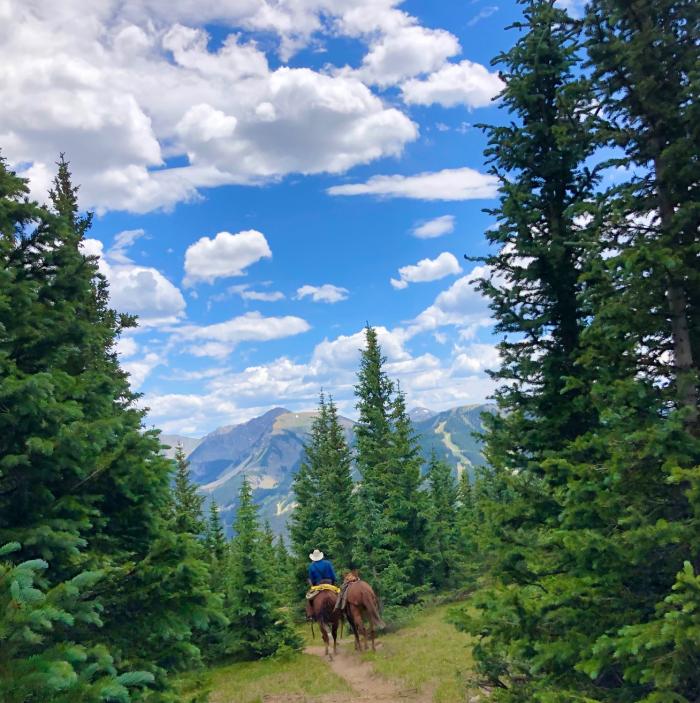
On the first day of autumn, I’m riding through a changing forest — tall, deep green ponderosas interspersed with the butter-gold of aspens, and shrubs ranging from pale crimson to deep russet to coral orange. It’s good to be on Charlie horse again, riding up and down the steep winding trails off Forest Road 476 in the mountains above Taos, New Mexico, after a summer hiatus from riding while I waited in vain for the heat to abate and the summer monsoon rains to start.
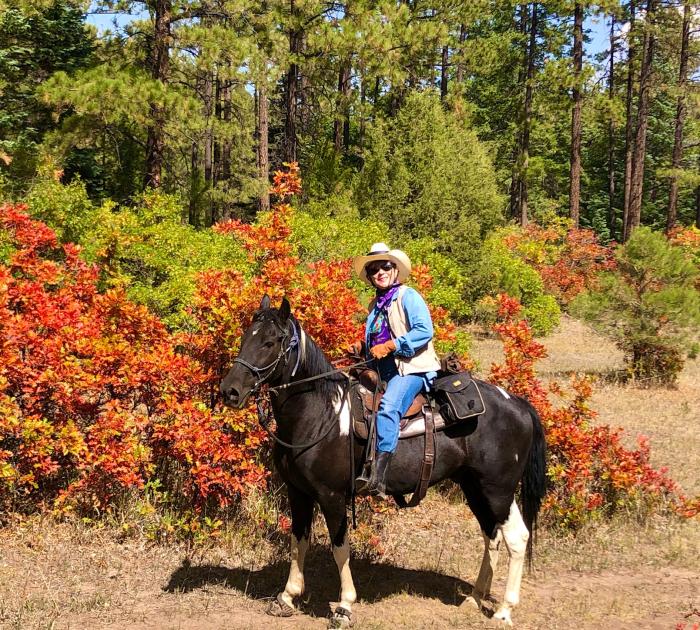
And it’s good to see my riding instructor of over two years, Kimberly Casara, the consummate cowgirl. Today we’re riding with RJ Francis, an avalanche safety expert and backcountry snowboard guide in his mid-30s. RJ boards his horses with Kimberly, and is an attentive horse dad and frequent rider. It’s so nice to see other humans at a safe physical distance and be able to enjoy the autumn beauty together as our conversation ranges from bridles to horse booties to local plant lore.

-------------------------------------------
I first committed to becoming a serious rider in the summer of 2018 when I rented a house in Arroyo Seco, a village north of Taos. I was not a complete novice. I had taken a few lessons in English riding when I was at the University of Sussex decades ago. And, oh yes, there was that 112-mile horse trek on Tibetan ponies around Amnye Machen, a sacred mountain in Eastern Tibet, in 2005.
But I wanted to learn to ride confidently, and to groom, saddle and untack a horse. I wanted to learn how horses think and act and react, and gain trust in my relationship with at least a couple of horses so that I wasn’t hesitantly asking for the gentlest horse every time I had a chance to trail ride.
I was encouraged by Tara Waters Lumpkin, the founder of Voices for Biodiversity and a close friend of 25 years. Tara, a Taos resident for decades, suggested I rent a nearby house that summer. She was determined to reconnect with her childhood passion for horses and wanted a riding buddy. As soon as I settled in, she gently pestered me until I’d set up my first lesson with Kimberly a week later.
Kimberly is a supportive teacher with a great deal of knowledge from her 16 years of experience. I can hear her voice repeating, “Be a calm, confident rider, be one with your horse,” over and over when I’m falling asleep. I’m not afraid, but perhaps a little reticent. I witnessed a couple of near-disastrous horse wrecks on our Tibetan horse trek, so I’m all too aware of potential dangers. Our inexperienced guide was nearly trampled when the horse he was unhitching got caught in the rope and reared frantically. Another day, a good friend went flying when her galloping horse stumbled over a marmot hole in a meadow at 12,000 feet.
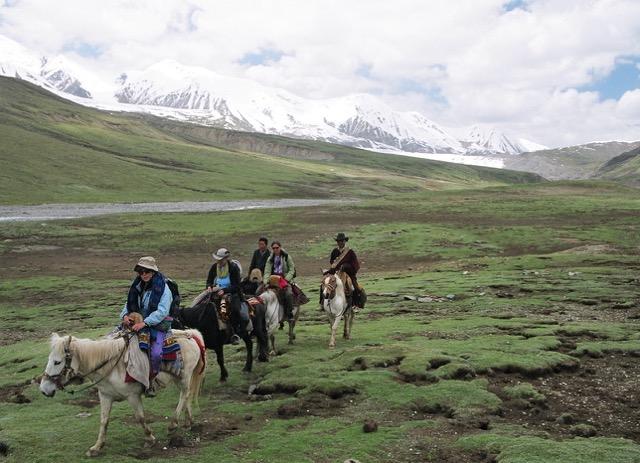
Tara was on that trip, too. In May 2005, we joined a service trip to provide midwifery training to the women in a remote village in Eastern Tibet. Tara was the anthropologist, overseeing a survey and needs assessment, and I was the documentary filmmaker. Tara was keen to do some riding after the training project was completed, and had meticulously researched the trek around Amnye Machen. Three others from our group decided to stay on and join us. No amount of research could have prepared us for the reality. I was blissfully unaware of how much danger we were in — crossing passes at 17,000 feet, and fording rivers in spring spate while gazing at jagged snow leopard’s-tooth mountains — until the final day, when Tara turned to me as we dismounted for the last time and said, “You have no idea how lucky we are that no one was seriously injured or killed.”
Kimberly drills me on the basics for my first few lessons on the beautiful and good-natured light bay Paso Fino mare Tilly, age 28 at the time. I’m thrilled when, after about five lessons, Kimberly gives me to the okay to join a trail ride.
Our first ride is out on the Rift Trail south of town, overlooking the deep canyon of the Rio Grande. We’re on that trail because the national forests are closed due to high fire danger, but it’s a good beginner’s trail. No steep drop-offs, no trees waiting to hit the knee of a rider who forgets to turn her horse’s head the right way. A few mountain bikers are all we have to contend with. Tilly is gentle and calm, and knows how to take care of less experienced riders.
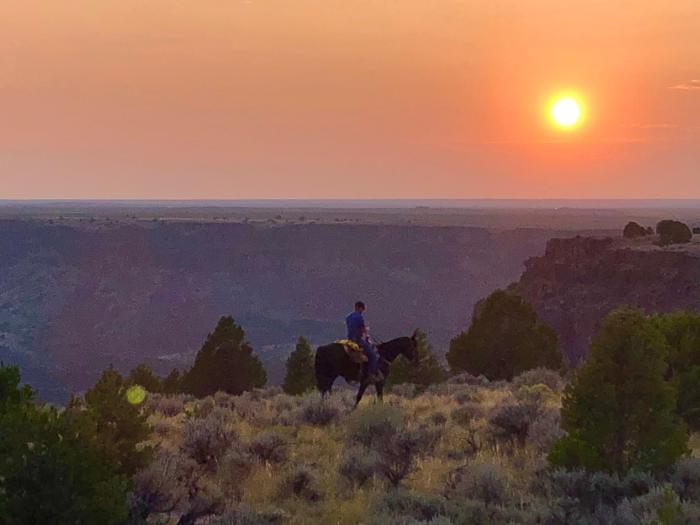
I listen to Kimberly’s reminders and relax into the saddle, enjoying Tilly’s smooth gait. The early summer morning is clear, the vast views of the Gorge from horseback are breathtaking and everyone feels good to be out on a ride.
Even after I moved back to my home outside Santa Fe that summer, I kept going back to Taos for lessons and trail rides. I improved and gained confidence. Toward the end of mountain riding season, Kimberly moved me onto Charlie, a black and white American Spotted saddle horse. I had to adapt to his larger size and different gait — he didn’t have Tilly’s butter-smooth Paso Fino gait. And he was just mischievous enough to test me on the first couple of rides by walking a little too near to a drop-off for my comfort, and banging my knee against the trunk of a tree because I hadn’t had the foresight to direct his head the right way.
That year, my riding season was over at the end of October, so I was eager to start up again in spring of 2019. Tara was a frequent companion on trail rides, and I also enjoyed meeting women and men varying in age from their teens to their late 80s. We’d talk boots and saddles, music and meals, restaurants and relationships. A lot of the time, we’d ride in companionable silence just looking at the nature around us. It was an exceptionally beautiful summer. The grasses grew long and high and swayed in the breezes. The wildflowers grew in abundance in a palette of colors — the red-orange of Indian paintbrush, the yellow of various daisies, the purple of penstemon, and the blue-violet lupine with slightly silvery leaves, beautiful but deadly for horses.
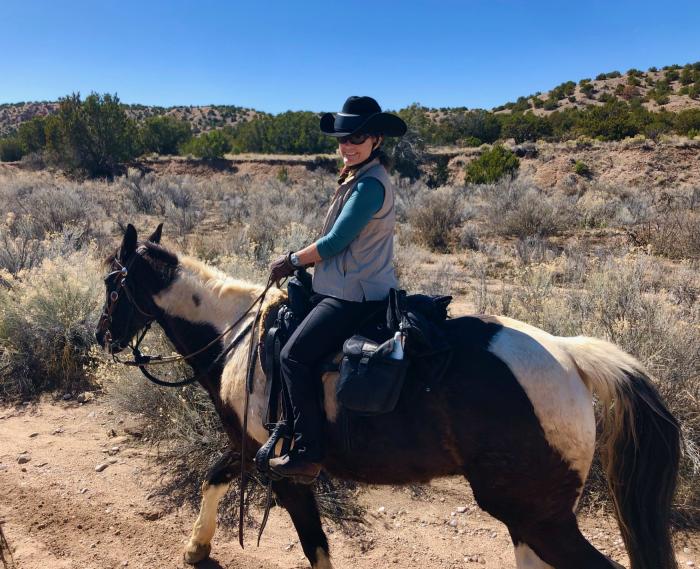
That summer wasn’t too hot, and what seemed like a paltry monsoon at the time now seems like an amazing abundance of rain. Autumn arrived with its brilliant kaleidoscope of azure sky setting off the tracery of golden aspen leaves shimmering and shivering in the breeze. There was always something new to be discovered, even when we rode the same trails. Every couple of weeks, they would look very different as the seasons progressed.
In December, I came back from a month overseas and joined a winter ride in Velarde, about 30 miles south of Taos. It had its own charms even though my feet froze as I realized that tight-fitting cowboy boots with thin nylon socks were not going to cut it for winter riding.
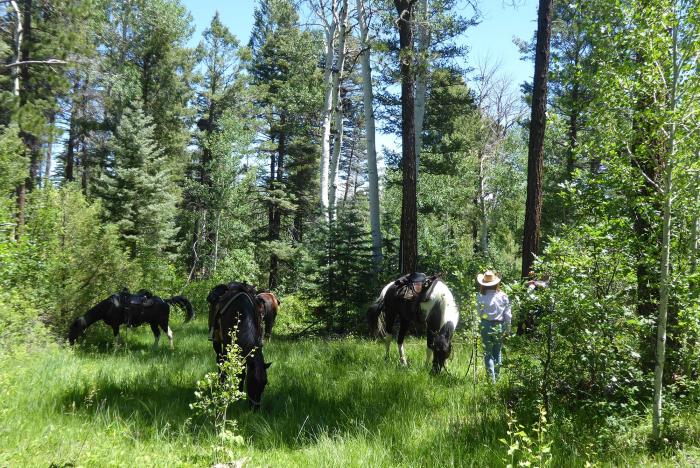
Kimberly, of course, rides nearly every day unless it’s icy or a thunderstorm is coming in. She has her own string of seven horses for lessons and trail rides — and because she loves them. And she has another seven horses that people board with her. Some are active horse-owners while others rely on Kimberly to keep them exercised.
-------------------------------------------
I was looking forward to starting riding again in spring 2020 when the pandemic hit and New Mexico was put under a stay-at-home order. We were allowed out for exercise, however, so I ventured up to Taos at the end of April, the longest drive my car had been on for months. Kimberly had moved the hitching posts to stand 10 feet apart, and since riding is inherently physically distanced, I felt safe. The trailhead is only a 15-minute drive up the road that runs through Talpa, so I took my own vehicle and met the horse trailer there.
I missed hugging Kimberly, and Tara when she rode with us, and shaking hands with new acquaintances. We sat farther apart during our meadow lunches than we used to but other than that, it felt so gloriously NORMAL to be out riding in the mountains in the spring, feeding Charlie an apple out of my hand, practicing leg signals, remembering to check my girth.
I had been making my way through all 13 seasons of Heartland, a horsey Canadian TV series about a teen girl who learned horse whispering from her mom, who dies in the first episode while they are rescuing a horse from an abusive owner in a storm. I was pretty much hooked from episode one. Stuck at home, I watched a couple of episodes most nights, following the character of Amy as she matures, always learning more about horses and hearts, all set in the scenic foothills of Alberta’s Rocky Mountains.
I rode nearly every week through May and June, getting up at 5:45 a.m. to be in Taos by 9 because there’s no longer the option of staying overnight with friends. I felt like Charlie remembered me even after we’d been apart for months. Touch-deprived like so many of us during the pandemic, I enjoyed the tactile feeling of grooming him with long strokes, brushing the dust out of his coat, combing tangles out of his tail, hugging him, and having him take horse cookies and apples out of my hand.
Charlie and I became “horse and rider as one” pretty quickly this season. He knows these trails like the back of his, well, hoof, and I just need to keep alert yet relaxed and to always pay attention. He did shy the time we were chased by a stray yearling calf, but I immediately turned him in a circle as Kimberly taught me to do. The poor calf had been left alone in the forest all winter and was lonely for companionship, any companionship, human, equine, whatever.
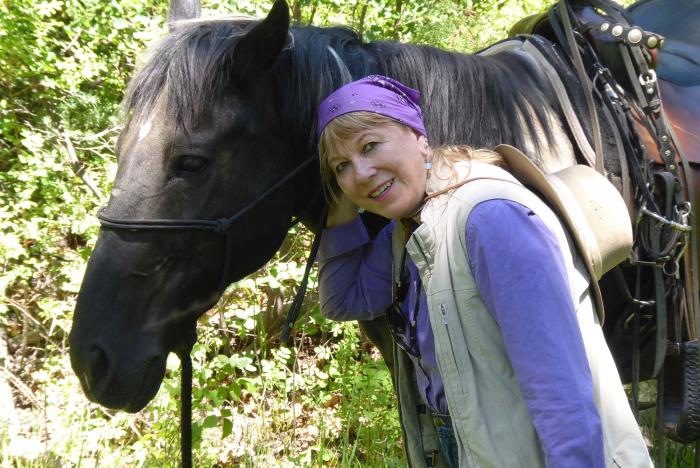
Kimberly’s oft-repeated instructions keep me on track. I jokingly told her that I think I’ve picked up a lot of tips from watching Heartland, which she also watches. Almost every night I was watching some aspect of riding — from trail rides to healing “problem” horses to rodeos to racing. A lot of it is observing how horses move and how they interact with humans. I realized that my little bit of trepidation in approaching these large and powerful animals was gone, replaced by a healthy respect. I’m now confident in my ability to communicate clearly to Charlie what I want and expect, and to be the boss whether I’m in the saddle or grooming him after a ride. A bond of affection has grown between us, probably helped along by the organic apples I bring as after-ride, thank you treats.
-------------------------------------------
For the autumn equinox, I book a staycation at the Adobe and Pines Inn, minutes from Kimberly’s barn, upgrading to a room with access to a hot tub. It has been two and a half months since I’ve been on a horse, so I also book a lesson. It is, as Gene Autry sang, great to be back in the saddle again.
That night, Kimberly and I meet at Doc Martin’s for dinner out on the patio. I don’t think we’ve ever seen each other in anything other than riding gear, and I’m in an actual dress and my hair is down. It’s nice to just talk as girlfriends while enjoying spicy food and the crisp night air. We haven’t seen each other since the beginning of July, so we share about how we’ve been feeling, what we’ve been thinking, how friends are doing, how her family is doing.
All of us who are part of her “barn family” as she calls us share a great love of animals, not just horses. She’s worried about a friend’s dog who had an accident. She cries when I tell her the story of my housemate’s elderly cat, who had to be put to sleep on the day she finished her quarantine and they were moving into my home. We’re both misty-eyed, and it’s not from alcohol.
The next day is the first day of autumn. After saddling up Charlie at Kimberly’s barn, I meet her and RJ at the trailhead. We’re soon in an autumn wonderland, well above the endlessly smoky skies that have plagued New Mexico and most of the American West for the past few weeks due to the mega-fires on the West Coast. I try to overlook how dry the land is, but can’t help noticing that the streams are silent and the stock tanks, other than the spring-fed one, are dried up. The grasses just never grew this year, and Kimberly says there were a lot of cattle in the forest (hers were pastured in Velarde this year) so what we are seeing is partly the result of overgrazing.
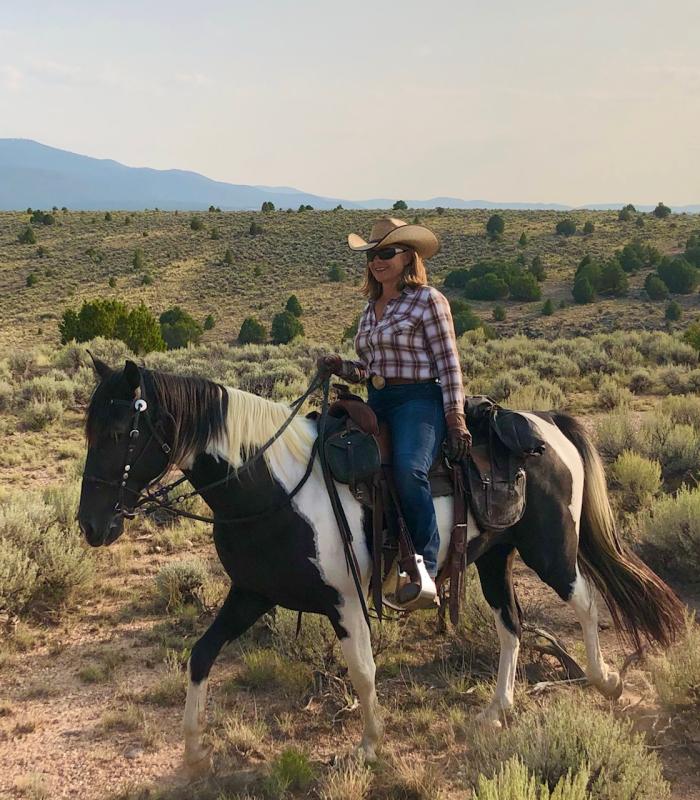
Our agreed-upon conversation rules for this pandemic year are no politics and no COVID-talk. We’re good about the politics. I’m pretty sure that all of us who ride together do not share the same views or favor the same candidates. But our friendship as barn family is more important than arguments that would convince no one of anything. Not only that, but it’s hard to stay in the moment — a necessity when one is riding a horse, especially in the mountains — if we are obsessing about politics.
We tread gently around COVID, occasionally slipping into the subject for a moment just because the pandemic currently dominates the lives of all human beings on the planet (except maybe in New Zealand). But we quickly pivot to riding gear, different types of saddles (which I don’t know much about, so I just ride and listen as they talk about custom-made saddles) and the plant life around us.
Kimberly, RJ and I share an interest in healing herbs, especially those that might boost the immune system. RJ is familiar with osha, and I’m curious to see this plant. My Cree Medicine Woman Nicole Gladu had suggested keeping its strong-smelling root around for any throat ailment and for immune support. I’ve known about osha for decades but had never seen it in the wild. RJ finds one little plant, its lacy leaves already faded to yellow-orange, and brings it to me to smell. I breathe in the pungent smell of its root, and then give it back to the Earth with gratitude.
It’s a beautiful day and there are even puffy white and gray clouds, teasing reminders of the failed monsoon. But when thunder begins to rumble off in the west, Kimberly says we need to get going. We don’t want to get caught out in a lightning storm on a mountainside. The horses feel that our energy is up so we each take command, making good time back down the mountain to the safety of the trailer. I hadn’t done a lot of trotting on Charlie before, but both of us are up to the task and thoroughly enjoy the ride.
The earthy scent of the rain falling on the long-dry ground, called petrichor, is beautiful and heartening, even though only a few drops of rain actually make it to the ground. This gorgeous autumn day will be a good memory to comfort me through the ongoing pandemic. And now that I’ve got myself some proper winter riding gear and the possibility of traveling this winter is non-existent, look for me somewhere out on the trail, grateful for the opportunity to keep myself sane, connected to nature and grounded.
